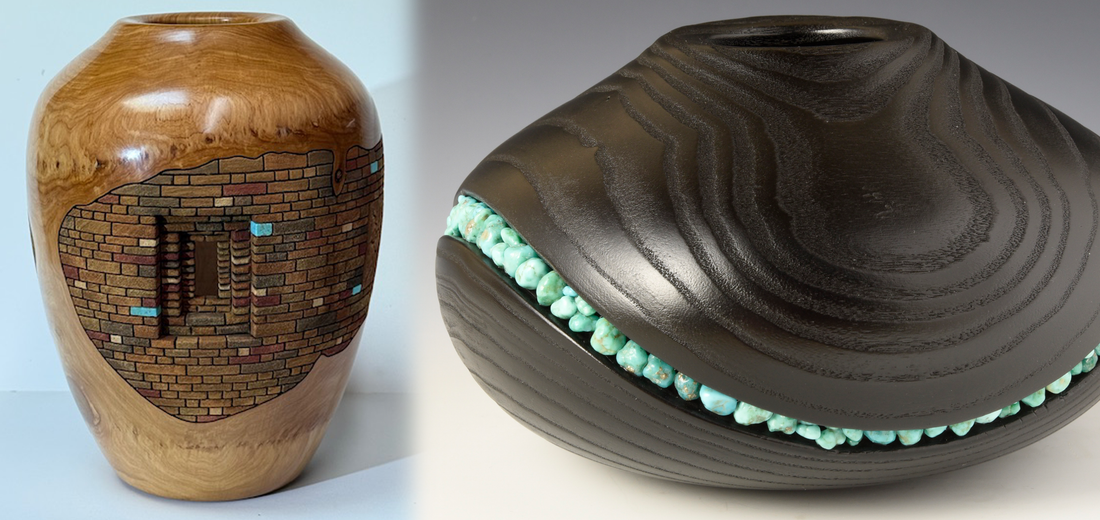
Jim McLain, our Featured Woodturner in Part 1 (click to read) has been a long time Pentacryl user - for over 16 years. Just recently, I happen to discover his “road to Pentacryl” in a conversation with Jim.
When Jim was asked if he could share a photo of a turned bowl that cracked - one that he hadn't applied Pentacryl to - he couldn't help us there. He always uses Pentacryl!
Jim: Sorry, I treat all of them, but I do get some failures even with Pentacryl. Drying wood in southern New Mexico has its challenges.
Kim (PS): Yes, hot areas are challenging when you are wanting the wood to dry slow. Curious what percentage of cracking would you say you get?
Jim: I probably get less than 10% with cracks and the cracks are small. Prior to Pentacryl, when I used other methods, it was more like 30-40% with some so large the blank was not usable.
Kim: That is good to hear! Thank you for the feedback. Just curious on what some of the other methods were?
Jim: I started with green wood sealer, then used PEG, dish soap, denatured alcohol, denatured alcohol and dish soap mixed together, microwave, green wood sealer again, then Pentacryl. Tried desiccant beads too, after Pentacryl a couple of times without success. Have been wanting to try boiling but have enough wood to last until I retire from Gallery work.
Kim: Oh my, those are a lot of different methods! Glad you stopped at Pentacryl - haha! By the way, you should never retire from woodturning!
Jim on keeping the pith in the turning blanks using Pentacryl:
“Not unlike treating a wood cookie, Pentacryl reduces the shrinkage and cracking allowing me to leave the pith in the turned vessel. It works well enough that I can turn a crotch section of a tree with three piths and once treated, it will dry with minimal cracking or no cracking. Some of the fruit woods still have some cracking after treatment but without they would be unusable”.
GALLERY
Below are some highlights of Jim’s woodturnings pieces over the years. Please follow Jim at www.instagram.com/jimmclainwoodturner to see more!
1.
The piece is made from Chinese Pistache a very hard (difficult) wood to cure without cracking because it moves a lot. Pentacryl allows me to cure it with the pith included. Drying wood in New Mexico is quite a challenge but Pentacryl is a big help.
2.
This Ash piece was rough turned, stabilized with Pentacryl, re-turned, burnt and stained.
3. 
I do not do many functional pieces but did this piece of Live Oak. It does have some minor cracking, but without Pentacryl, it would not have been usable. Live Oak is probably the worst wood as far as wood movement goes and this piece had some nice crotch wood in it.
4.
This is a recent turning that I did from Russian Olive. I have started finishing with CA glue/super glue and the pieces are very glossy so are a little harder to photograph.
5.
This unique piece of mountain juniper has several vertical turquoise inlays.
6.
One large mountain juniper vase with turquoise inlay. I am now finishing these with superglue - which makes them very shinny and hard to photograph.
7.
A tall narrow piece of screw bean mesquite with several large inlays in the bark inclusions. Mesquite is very stable, but I treat it with Pentacryl to be on the safe side. Would hate to lose a piece this beautiful to cracking. I almost made this one a keeper.
8. 
Kentucky Coffee wood, stabilized with Pentacryl. The grain was dug out and peridot glued in.
Chaco Series
1.
Alligator Juniper with stones from the Chaco series. Also turned with the pith included.
2.
Chaco Passages sphere in alligator juniper with the pith included.
3.
Chaco Passages tall vase in alligator juniper. With turquoise inlay and petroglyph.
4.
Another Chaco piece made from Alligator Juniper. The inlay was done in a large bark inclusion.
5.
This is one of my newest pieces, but it has been sold. I call it an Horno Shaped Chaco Passages. It is about 10 inches in diameter by 12 inches tall. Made from Alligator Juniper and of course cured with Pentacryl.
6.
This is probably the third or fourth Chaco Steps I have done over the years, but it is the newest. Still available at the gallery. This is one of my favorite pieces.
7. 
In progress photo:

Here is a pic of my latest piece entitled Ancient Ones. It is made from Alligator Juniper and is approximately 9 wide by 20 tall! It has turquoise and dinosaur bone bricks. The vase is rough turned, soaked in Pentacryl, turned a second time, all the bricks carved, sandblasted and then stained using artist pigments.
The turquoise bricks are easy to spot. If you look carefully, you can see the dinosaur bone bricks. About 30-40 stone bricks are inserted into the carved bricks.
8. 
This is one of the Cave Seven pieces under the Chaco series. It also has some dinosaur bone included. The bottom half of this piece is beaded and lines burnt to mimic an ancient Native American basket. A lot of wood turners use this basket illusion technique.
9. 
Detail:

This special Chaco vase is made from bumpy alligator juniper, is 10 ¼” tall by 7 ½“ wide, contains Jim’s favorite Chaco petroglyph, and is owned by Preservation Solution's own Kim Prinzi Kimbro.
"After all these years, I can’t believe I have a Jim McLain Chaco vase in my possession!" - Kim
From Jim: “I forgot to warn you that once you have one if my pieces you will want more. I have one customer in Eagle, CO that has 8 Chaco pieces.” Jim, Kim will likely be coming for more!


